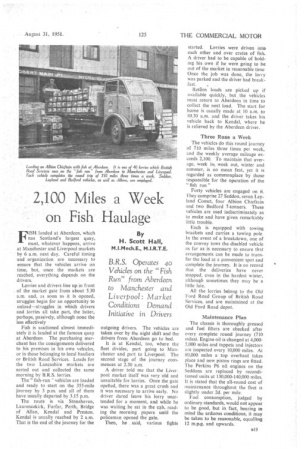2,100 Miles a Week on Fish Haulage
Page 47

If you've noticed an error in this article please click here to report it so we can fix it.
By H Scott Hall, M.I.Mech.E., M.I.R.T.E. F1S1-. 1 landed at Aberdeen, which has Scotland's largest quay, must, whatever happens, arrive at Manchester and Liverpool markets by 6 a.m. next day. Careful timing and organization are necessary to ensure that the vehicles arrive on time, but, once the markets are reached, everything depends on the drivers.
Lorries and drivers line up in front of the market gate from about 5.30 a.m. and, as soon as it is opened, struggles begin for an opportunity to unload—struggles in which drivers and lorries all take part, the latter, perhaps, passively, although none the less effectively
Fish is auctioned almost immedi, ately it is landed at the famous quay at Aberdeen. The purchasing merchant has the consignments delivered to his premises in his own vehicles, or in those belonging to local hauliers or British Road Services. Loads for the two Lancashire markets are sorted out and collected the same morning by B.R.S. terries.
The " fish-run' vehicles are loaded and ready to start on the 355-mile journey by 3 p.m. and all of them have usually departed by 3.15 p.m.
The route is via Stonehaven, Laurencekirk, Forfar, Perth, Bridge of Allan, Kendal and Preston. Kendal is usually reached by 2 a.m. That is the end of the journey for the outgoing drivers. The vehicles are taken over by the night shift and the drivers from Aberdeen go to bed.
It is at Kendal, too, where the fleet divides, part going to Manchester and part to Liverpool. The second stage of the journey commences at 2.30 a.m.
A driver told me that the Liverpool market itself was very old and unsuitable for lorries. Once the gate opened, there was a great crush and it was necessary to arrive early. No driver dared leave his lorry unattended for a moment, and while he was waiting he sat in the cab, reading the morning papers until the policeman opened the gate.
Then, he said, various fights started. Lorries were driven into each other and over crates of fish. A driver had to be capable of holding his own if he were going to be Out of the market in reasonable time Once the job was done, the lorry was parked and the driver had breakfast.
Itet(Irn loads are picked up if available quickly,. but the vehicles must return to Aberdeen in time to collect the next load. The start for home is usually made at 10 a.m. to 10.30 a.m. and the driver takes his vehicle back to Kendal, where he is relieved by the Aberdeen driver.
Three Runs a Week The vehicles do this round journey of 710 miles three times per week, and the weekly average mileage exceeds 2,100. To maintain that average, week inm week out, winter and summer, is no mean feat, yet it is regarded as commonplace by those responsible for the operation of the " fish run "
Forty vehicles are engaged on it. They comprise 27 Seddon, seven Leyland Comet, four Albion Chieftain and two Bedford 7-tonners. These vehicles are used indiscriminately as to make and have given remarkably little trouble.
Each is equipped with towing brackets and carries a towing pole. In the event of a breakdown, one of the convoy tows the. disabled vehicle as far as is necessary to ensure that arrangements can be made to transfer the load at a convenient spot and complete the journey. It is on record that the deliveries have never stopped, even in the hardest winter, although sometimes they may be a little late.
All the lorries belong to the Old Ford Road Group of British Road Services, and are maintained at the Old Ford Road depot.
Maintenance Plan
The chassis is thoroughly greased and fuel filters are checked after every complete round journey (710 miles). Engine oil is changed at 4,0005,000 miles and tappets and injectors are inspected every 10,000 miles. At 80,000 miles a top overhaul takes place and new piston rings are fitted. The Perkins P6 oil engines on the Seddons are replaced by reeonditioned units at 130,000-140,000 miles. It is stated that the all-round cost of maintenance throughout the fleet is slightly under 2d. per mile.
Fuel consumption, judged by ordinary standards, would not appear to be good, but in fact, bearing in mind the arduous conditions, it may be taken to be reasonable, equalling 12 m.p.g. and upwards.




















































































